|
Collaboratively evolved, machine-processable semantics over the internet hold much promise for supporting collective sensemaking, but the technologies raise many interesting representational and interaction design issues. The mission of the ScholOnto Project has been to better understand these challenges in the context of enabling researchers (not trained librarians or ontology engineers) to engage in semantic scholarly publishing and discourse (for detailed analysis see Papers/Talks).
Over the project's 3 years, we have evolved a suite of prototype tools for modelling conceptual networks of ideas and arguments, publishing them for reuse and argumentation, and navigating, searching and filtering this repository as it grows. Some of these are now freely available to play with, but <warning!> we are no longer able to support them, so are not able to assist if you have problems or lose data</warning!>. |
|
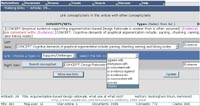 ClaiMaker is the first system that we built, and has evolved through the project: it is the web-based database server to which one publishes claim structures; via its menus it also provides a forms-based user interface for modelling claims, and Discovery Services for searching/filtering/visualizing the database (see also the subsequent ClaimFinder interface for accessing the Discovery Services).
ClaiMaker is the first system that we built, and has evolved through the project: it is the web-based database server to which one publishes claim structures; via its menus it also provides a forms-based user interface for modelling claims, and Discovery Services for searching/filtering/visualizing the database (see also the subsequent ClaimFinder interface for accessing the Discovery Services).
|
|
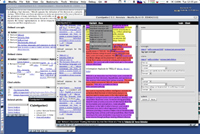 ClaimSpotter is the fruit of collaboration with Bertrand Sereno, tackling the challenge of providing active ScholOnto-style semantic annotation and navigation of Web documents. ClaimSpotter demonstrates semantic social bookmarking: we move from isolated tags attached to URLs, to semantic networks of tags; from tag clouds to what we might think of as tag webs. In addition, ClaimSpotter highlights the text to show how it has already been annotated, and experiments with text analysis techniques to highlight potentially significant sentences and argumentative claims. Demos and papers at the ClaimSpotter site.
ClaimSpotter is the fruit of collaboration with Bertrand Sereno, tackling the challenge of providing active ScholOnto-style semantic annotation and navigation of Web documents. ClaimSpotter demonstrates semantic social bookmarking: we move from isolated tags attached to URLs, to semantic networks of tags; from tag clouds to what we might think of as tag webs. In addition, ClaimSpotter highlights the text to show how it has already been annotated, and experiments with text analysis techniques to highlight potentially significant sentences and argumentative claims. Demos and papers at the ClaimSpotter site.
|
|
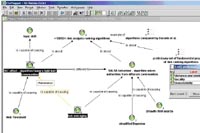 ClaiMapper is a single-user concept mapping application developed as a result of studying paper-based modelling and use of ClaiMaker. These showed that there is a strong cognitive requirement to draw maps of a literature in order to 'get the big picture', before one starts to model individual papers in detail. ClaiMapper allows the analyst to 'sketch' rough structures as informally as required, incrementally formalizing them to create coherent claim maps which can then be uploaded to ClaiMaker if one wants to share them, and/or take advantage of the server-based Discovery Services. In addition, the analyst can search the ClaiMaker repository and import/drag+drop concepts direct into ClaiMapper, ready for reuse in new maps. ClaiMapper is not available, but was was built on top of the Compendium hypermedia visual mapping tool, which is in use by thousands of users.
ClaiMapper is a single-user concept mapping application developed as a result of studying paper-based modelling and use of ClaiMaker. These showed that there is a strong cognitive requirement to draw maps of a literature in order to 'get the big picture', before one starts to model individual papers in detail. ClaiMapper allows the analyst to 'sketch' rough structures as informally as required, incrementally formalizing them to create coherent claim maps which can then be uploaded to ClaiMaker if one wants to share them, and/or take advantage of the server-based Discovery Services. In addition, the analyst can search the ClaiMaker repository and import/drag+drop concepts direct into ClaiMapper, ready for reuse in new maps. ClaiMapper is not available, but was was built on top of the Compendium hypermedia visual mapping tool, which is in use by thousands of users.
|
|
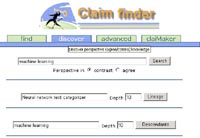 ClaimFinder delivers the Discovery Services via the tabbed search engine interface style with which Web users are most familiar, rather than as items embedded in a drop-down menu in ClaiMaker. The default page provides a simple, single-field form for users to do keyword searching, with 'advanced' search tabs delivering encapsulated services such as Perspective Analysis and Lineage.
ClaimFinder delivers the Discovery Services via the tabbed search engine interface style with which Web users are most familiar, rather than as items embedded in a drop-down menu in ClaiMaker. The default page provides a simple, single-field form for users to do keyword searching, with 'advanced' search tabs delivering encapsulated services such as Perspective Analysis and Lineage.
|
|
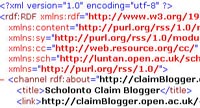 ClaimBlogger was an initial step in a new experiment to explore blogging and RSS syndicated news-channels as a paradigm for scholarly publishing and discourse. We envision 'semantic blogging' which uses ClaiMaker's relational scheme to add and connect blog entries and other websites which are mirrored in the claim network, and RSS newsfeeds as a paradigm for receiving filtered updates to new entries. ClaimBlogger is an initial exploration of searching and publishing elements from the ClaiMaker repository as RSS 1.0-compliant XML.
ClaimBlogger was an initial step in a new experiment to explore blogging and RSS syndicated news-channels as a paradigm for scholarly publishing and discourse. We envision 'semantic blogging' which uses ClaiMaker's relational scheme to add and connect blog entries and other websites which are mirrored in the claim network, and RSS newsfeeds as a paradigm for receiving filtered updates to new entries. ClaimBlogger is an initial exploration of searching and publishing elements from the ClaiMaker repository as RSS 1.0-compliant XML.
|
|
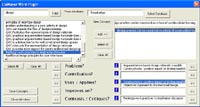 ClaiMaker Microsoft Word plug-in: One approach to tool deployment is to integrate any new tasks (in this case, claim construction and submission) with existing tools. When one needs to model the arguments in one's own, new papers, we hypothesise that claim construction might be best done as one is thinking about the conceptual structure of one's paper, that is, during writing, to minimise the delay between the expression of the idea in conventional prose, and its formalization. As a first step we have implemented a Microsoft Word plug-in which authors can launch direct from the Word toolbar [described in more detail in IJIS paper].
ClaiMaker Microsoft Word plug-in: One approach to tool deployment is to integrate any new tasks (in this case, claim construction and submission) with existing tools. When one needs to model the arguments in one's own, new papers, we hypothesise that claim construction might be best done as one is thinking about the conceptual structure of one's paper, that is, during writing, to minimise the delay between the expression of the idea in conventional prose, and its formalization. As a first step we have implemented a Microsoft Word plug-in which authors can launch direct from the Word toolbar [described in more detail in IJIS paper]. |
|
 The ScholOnto RDF Schema is available. The ScholOnto RDF Schema is available.
|




